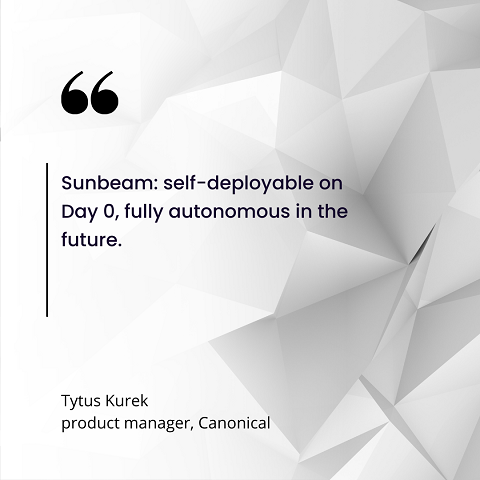Canonical wants to make it easier than ever to bring OpenStack to your data center — or virtually anywhere else you might want to run a private cloud — through Sunbeam, a new open source offering that the company announced on June 13.
Will Sunbeam drive further adoption of OpenStack, the open source platform whose death has been declared more than once in recent years? Read on for a closer look at the new solution and what it might mean for the world of OpenStack.
What Is Sunbeam OpenStack?
As you probably know if you follow cloud computing news, OpenStack is an open source solution for building private clouds. First released in 2010, OpenStack lets organizations configure servers into pools of resources that can be used on demand, via an infrastructure-as-a-service (IaaS) model. That allows companies to build something resembling a public cloud environment, except they own and have full control over the infrastructure.

Canonical, the company best known as the backer of Ubuntu Linux, has for years offered a distribution of OpenStack called Charmed OpenStack. With Sunbeam, which Canonical is for now calling an "extension" of its main OpenStack offering, the company hopes to solve two main challenges associated with traditional OpenStack:
- Difficulty of deployment and management: Canonical said in a statement that Sunbeam "comes with a lucid interface and very simple installation instructions" that admins can use to launch a fully functional environment in "minutes," even if they lack previous OpenStack experience. That's a big improvement over traditional OpenStack deployments, which can take weeks to plan and implement.
- High resource requirements: Sunbeam is a lightweight OpenStack variant that is designed to be "usable on machines with limited hardware resources, including workstations and VMs," according to Canonical. This feature should help make Sunbeam attractive to organizations that want to set up private clouds using small pools of servers, rather than massive infrastructures (although, as noted below, Canonical sees Sunbeam as a solution for large-scale infrastructures as well).
Based on these advantages, Canonical is touting Sunbeam as an OpenStack offering for businesses that don't want to pay teams of consultants to deploy or manage OpenStack.
"Over the years nobody, including us, managed to assemble the right way to deliver and operate OpenStack, turning it into a consulting ware" that required specialized expertise to deploy and manage, Tytus Kurek, product manager at Canonical, told Data Center Knowledge. "Hence, our investment in Sunbeam: self-deployable on Day 0, fully autonomous in the future."
Canonical also said that it sees Sunbeam as a solution for businesses that need a way to operate "large-scale cloud environments where lightweight solutions, such as bare metal K8s, fall short," according to Kurek. As examples of Sunbeam use cases, he mentioned "AI/ML, HPC environments, and telco NFVI [network functions virtualization infrastructure]," adding, "due to its comprehensive APIs and interoperability, OpenStack will provide capabilities not available anywhere else."
Changes to Canonical's OpenStack Strategy
For now, Canonical plans to offer Sunbeam alongside its traditional OpenStack distribution. But as Sunbeam matures and gains more features, the company will pivot to Sunbeam as its primary OpenStack offering.
"Once Sunbeam achieves feature parity with Charmed OpenStack, it will become Canonical's default delivery and operations framework for OpenStack moving forward," Kurek told Data Center Knowledge. "It will be supported on any scale, while also bringing additional benefits over OpenStack Charms, including low entry barrier, human-friendly interface, lightweight architecture, and an improved upgrade experience."
That's notable because it suggests that with Sunbeam, Canonical is doing more than just building a niche OpenStack distribution designed for smaller-scale deployments. The latter use case appears to be at the center of Canonical's Sunbeam vision in the near term, but eventually, the company's goal is apparently to bring a radical new degree of usability to OpenStack use cases of all types.
If that happens, folks (including myself) who have declared OpenStack's heyday over might have to eat their words. Arguably, OpenStack never reached its full potential as a way for companies to build private cloud environments and avoid the drawbacks of public cloud largely because OpenStack was really hard to use. By offering a much more user-friendly take on OpenStack, Canonical might finally bring the platform the love it has been missing for so many years.
A New Opening in the OpenStack Market?
Canonical thinks the OpenStack market is ripe for disruption right now because more companies are looking for ways to deploy private clouds without using proprietary platforms, like VMware.
"The acquisition of VMware by Broadcom creates a significant opportunity for OpenStack, with all the companies in the enterprise sector now feeling uncertain about the potential licensing cost increase," Kurek said. "We are already seeing some of those organizations looking into open source as a reasonable alternative. Likewise, we’re observing an increasing interest in OpenStack since the acquisition date."
That's a big bet — there's no evidence currently that organizations are flocking away from VMware — but given the choice between open source and proprietary solutions, most businesses will choose the open source offering as long as it's competitive in terms of usability and support. Making open source the easy choice for companies looking to create private clouds seems to be Canonical's long-term vision as it rolls out Sunbeam.





